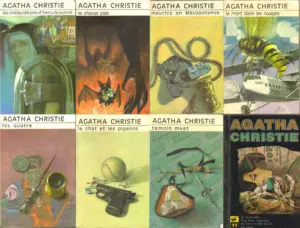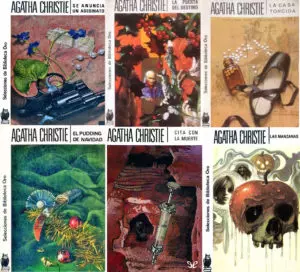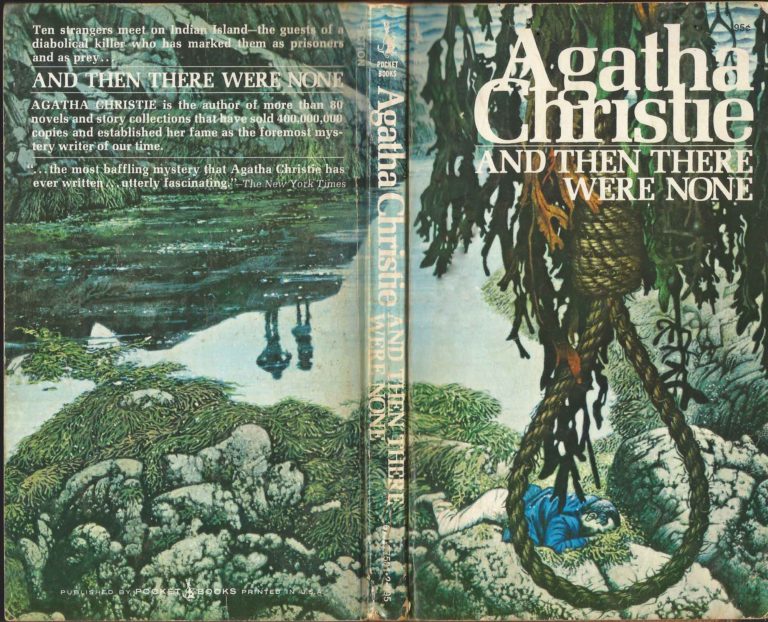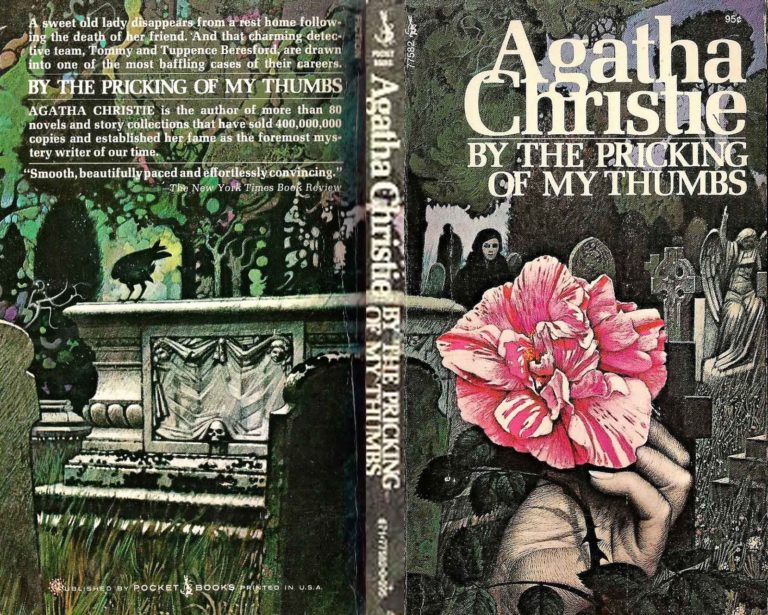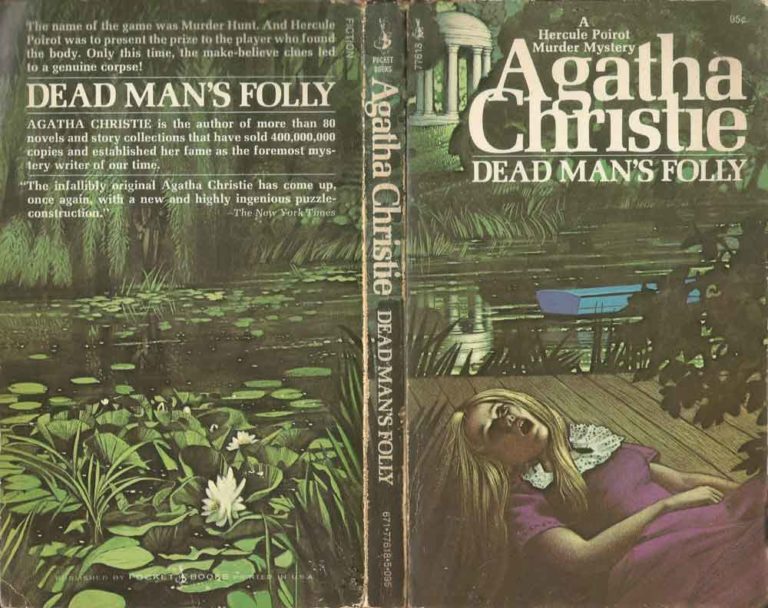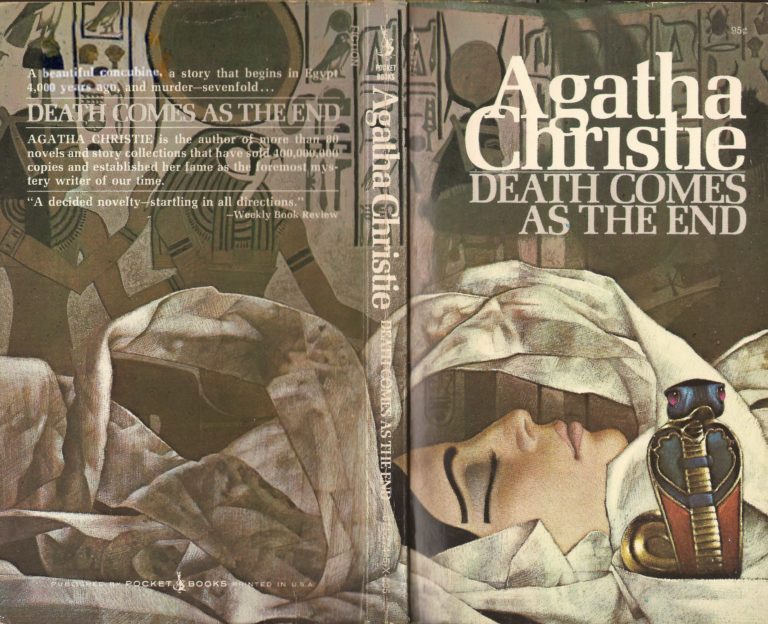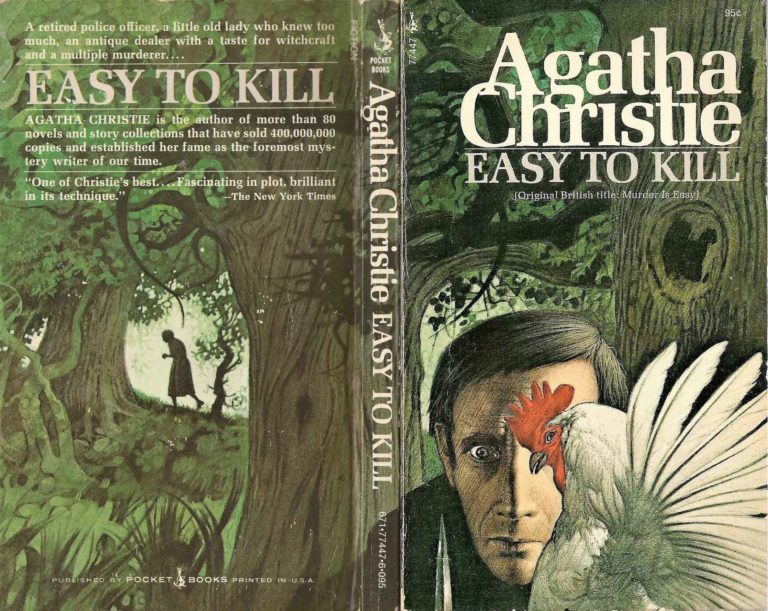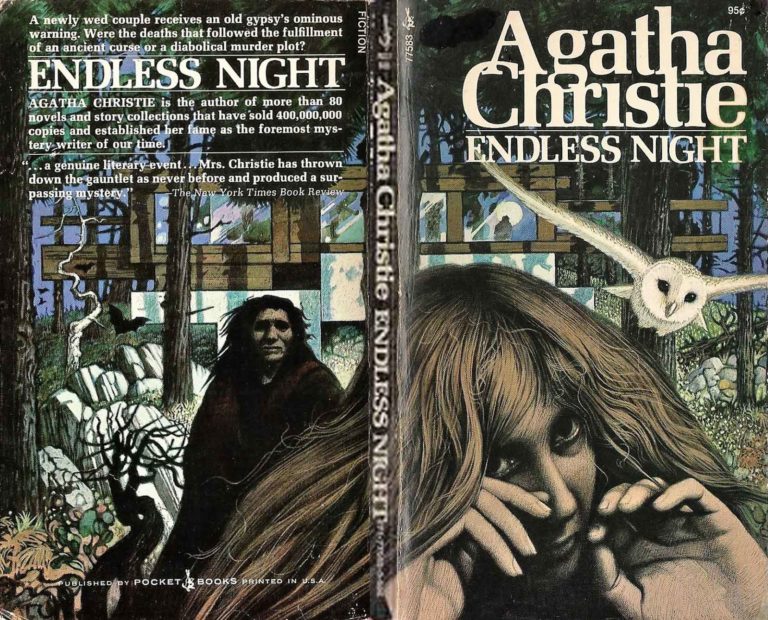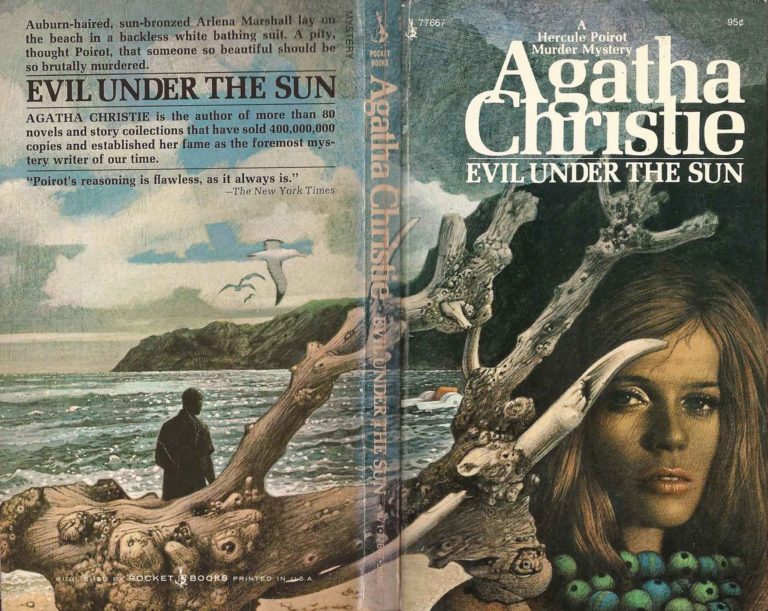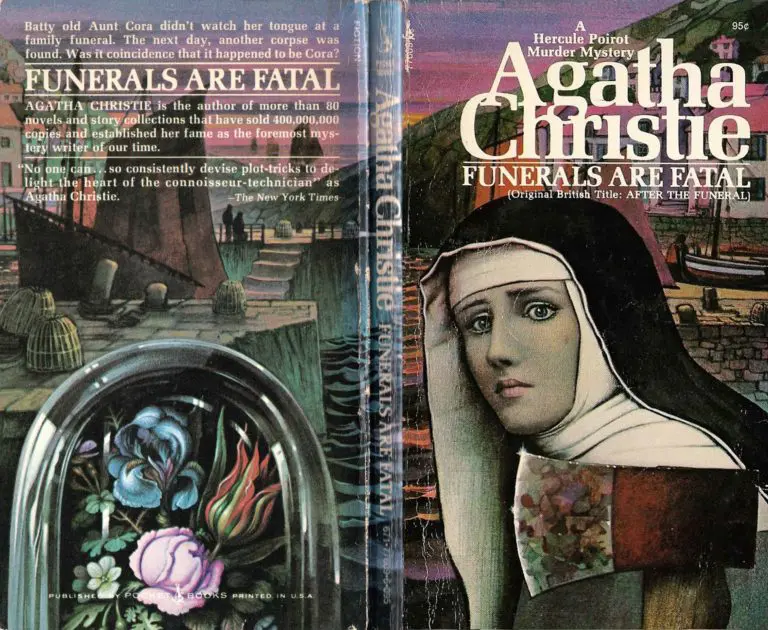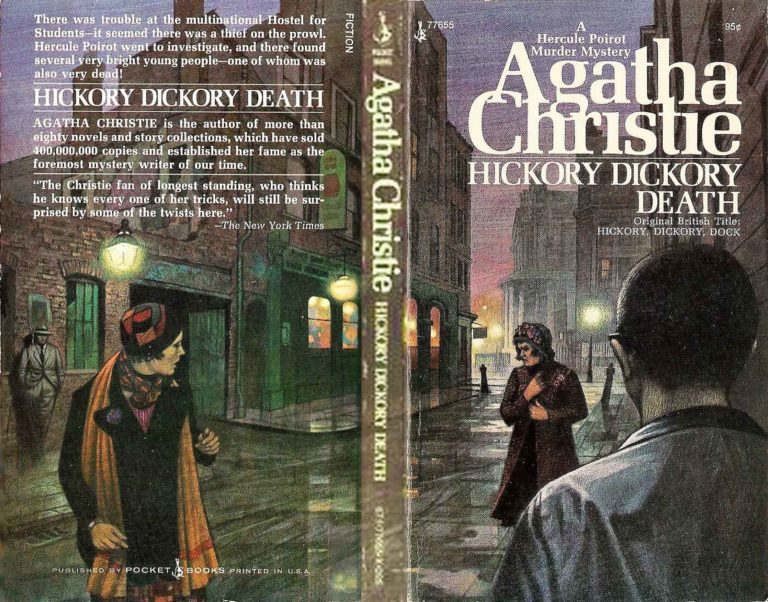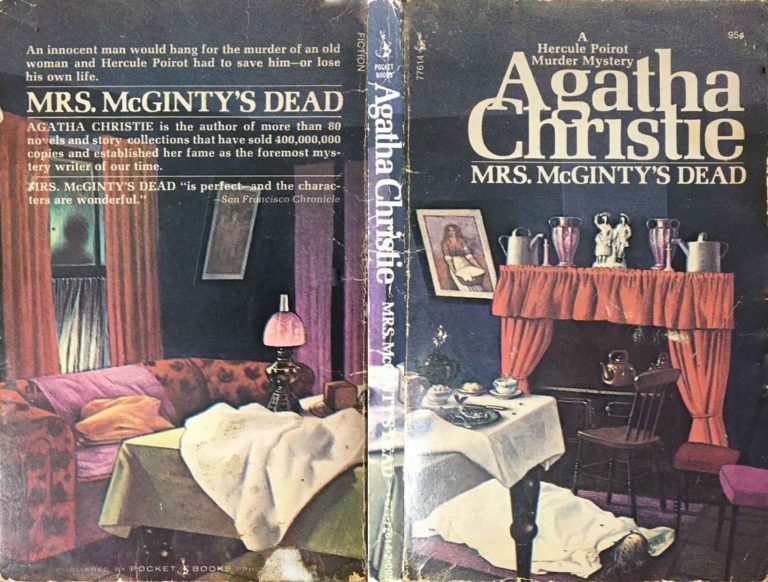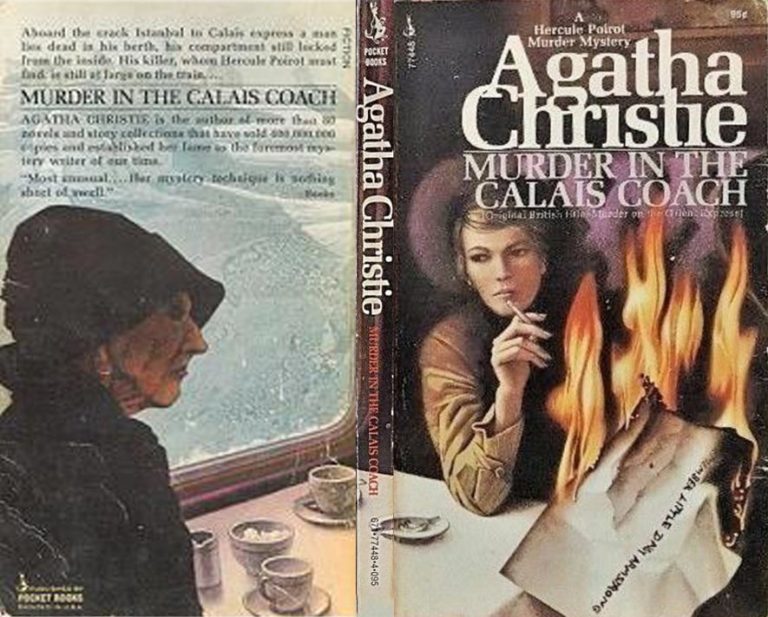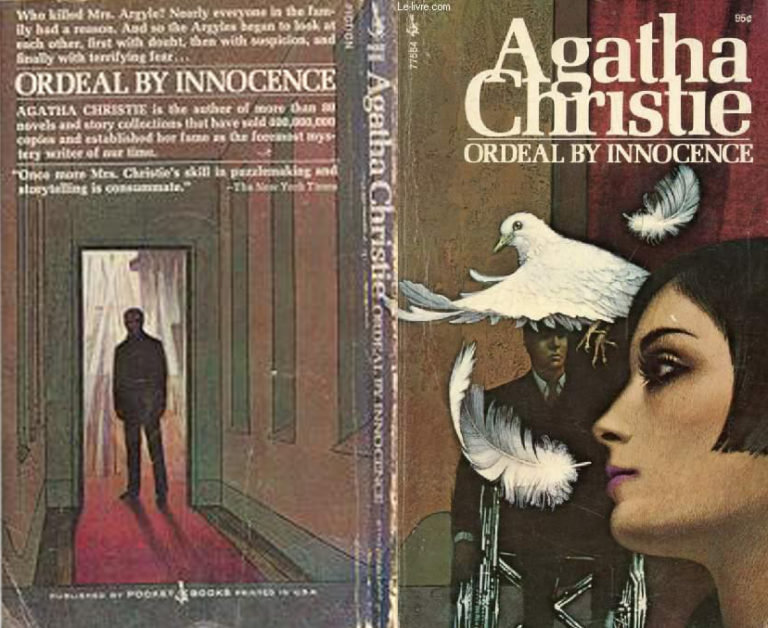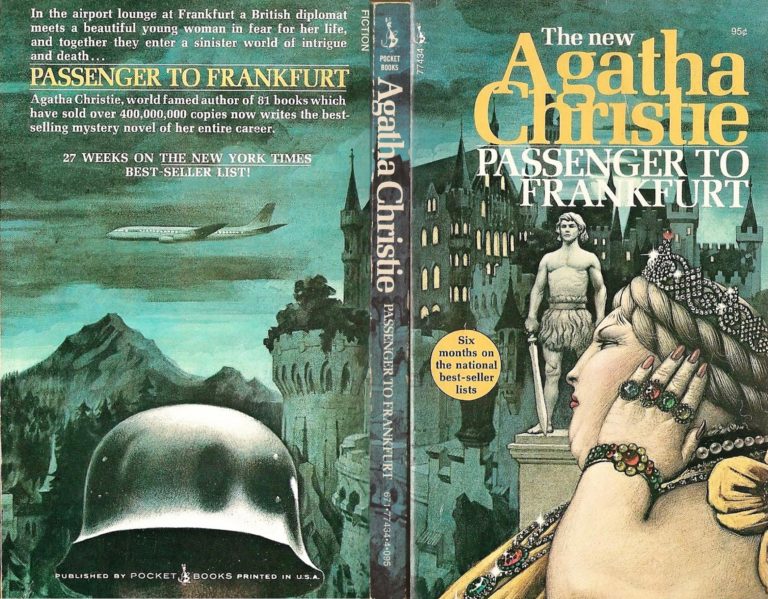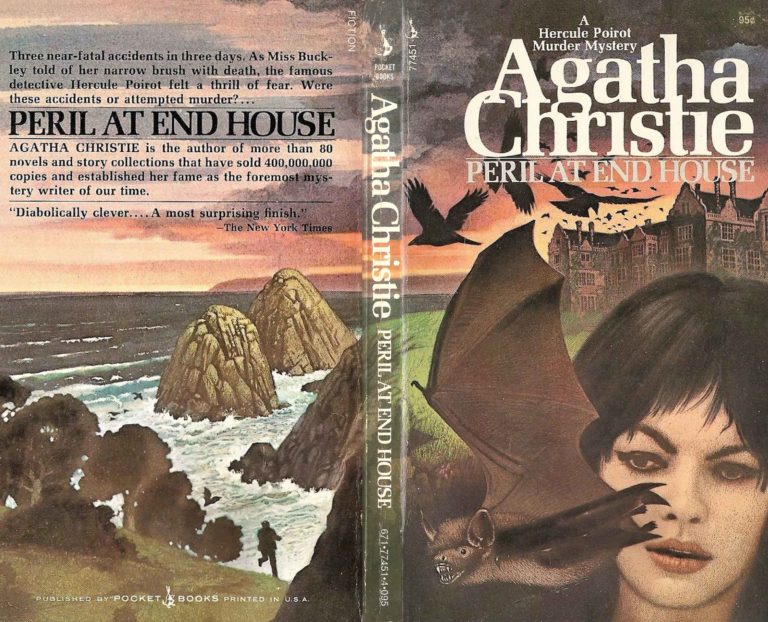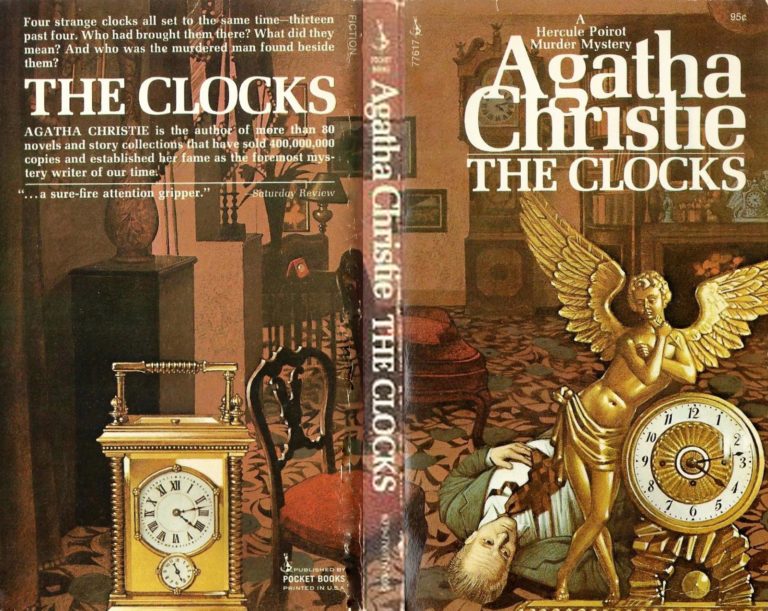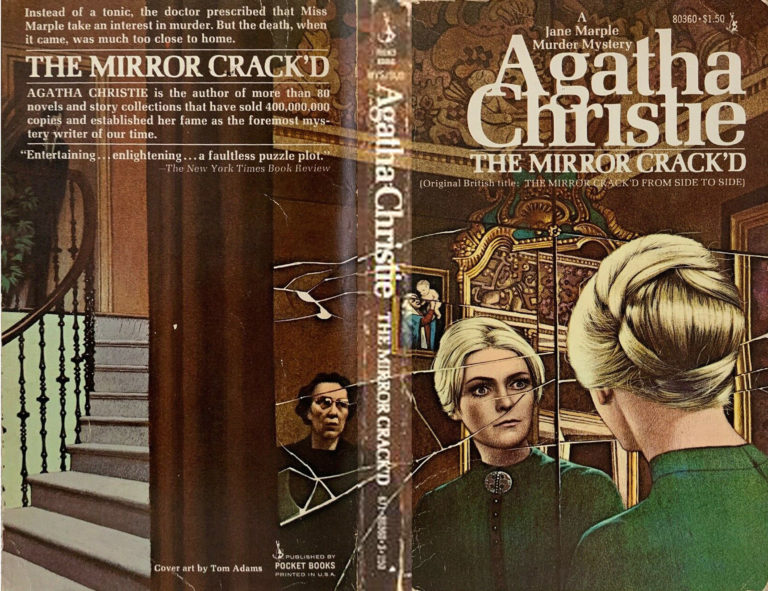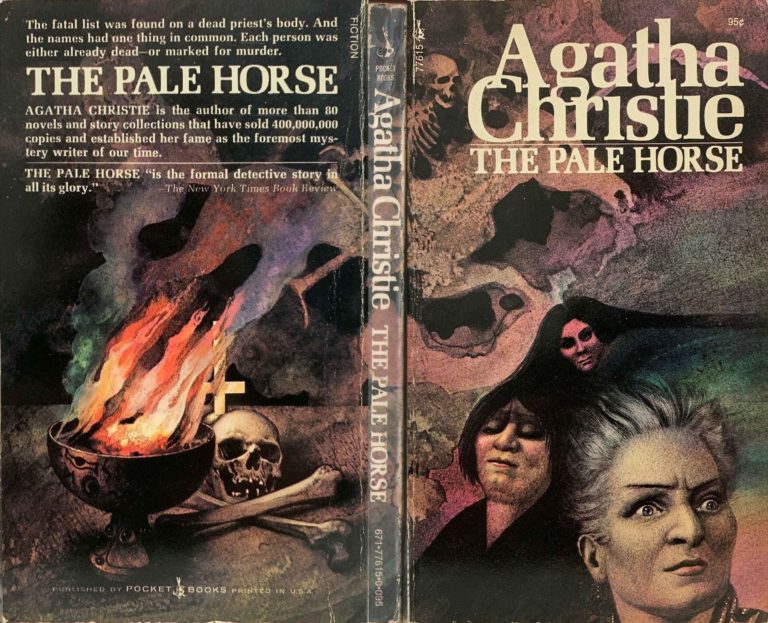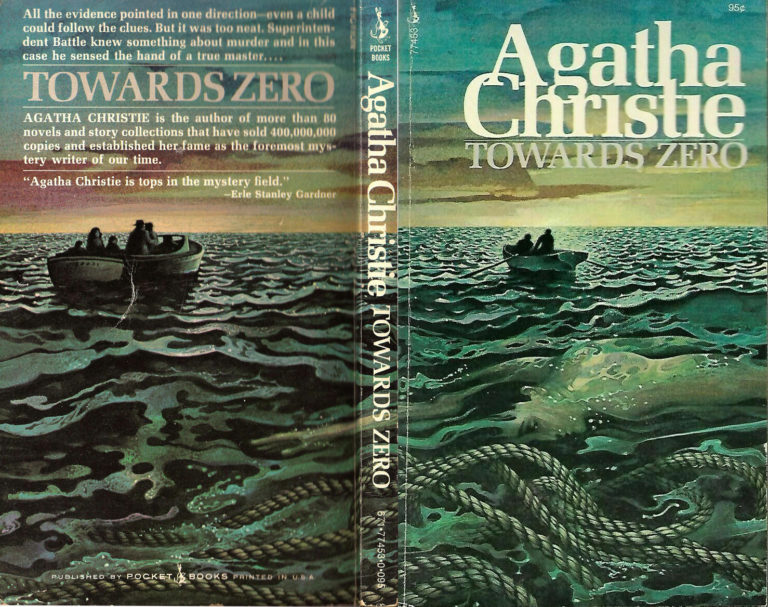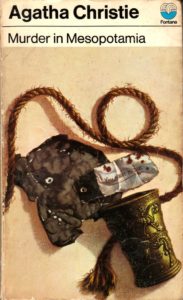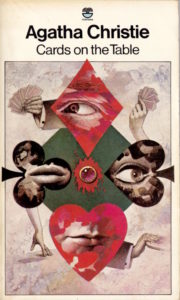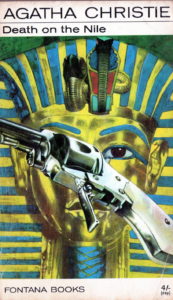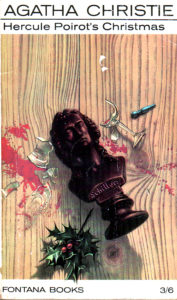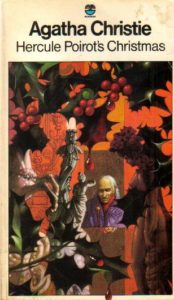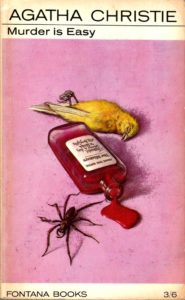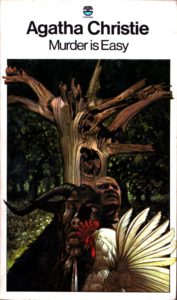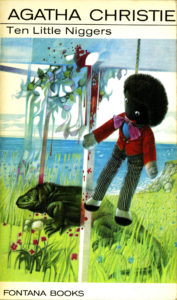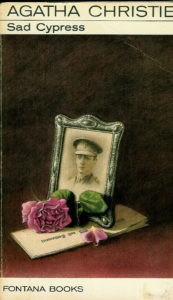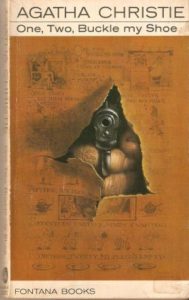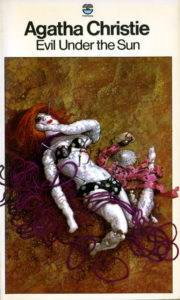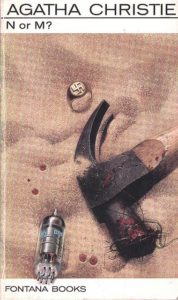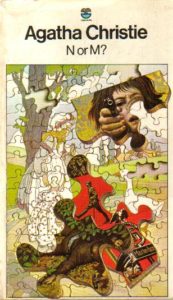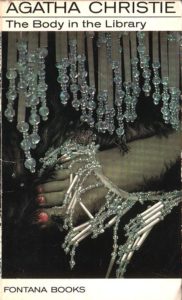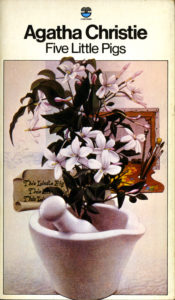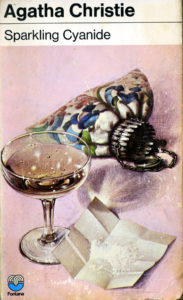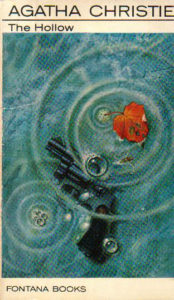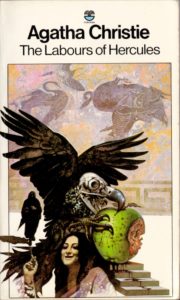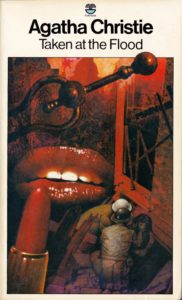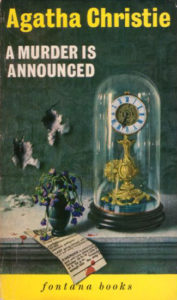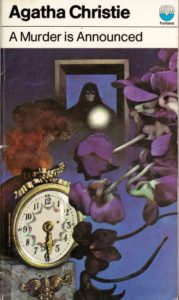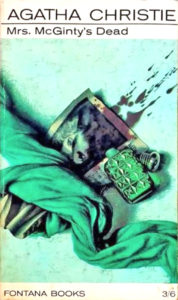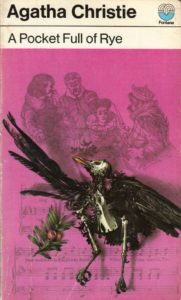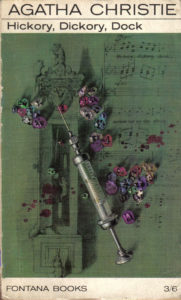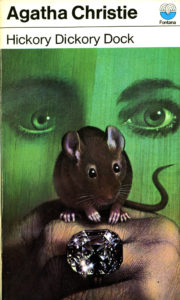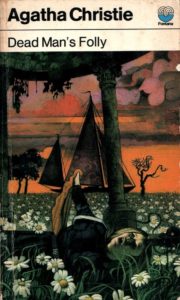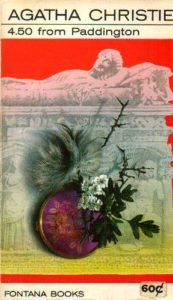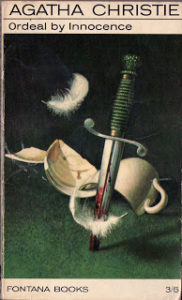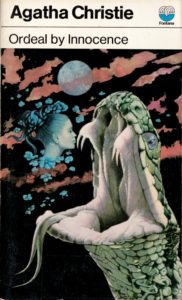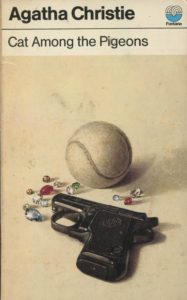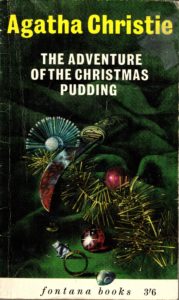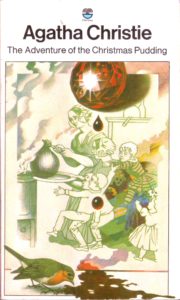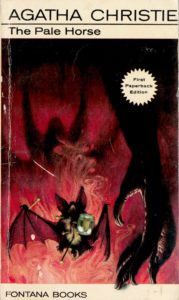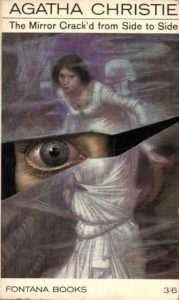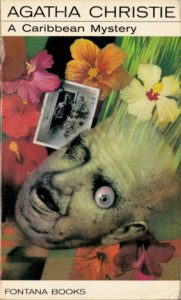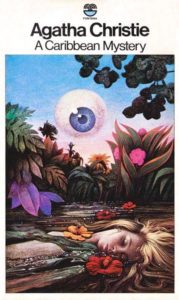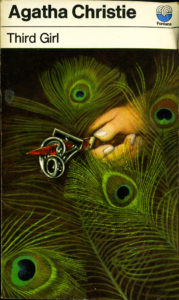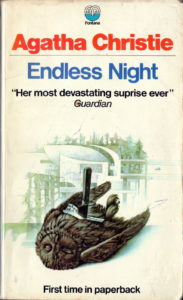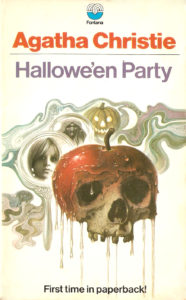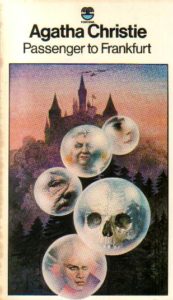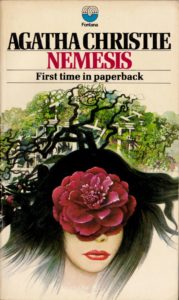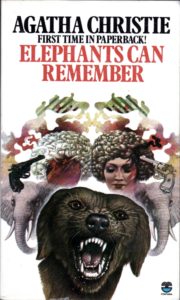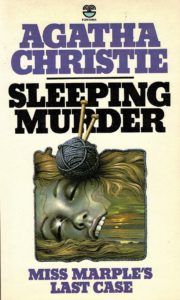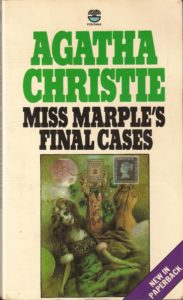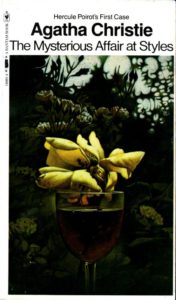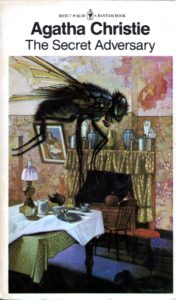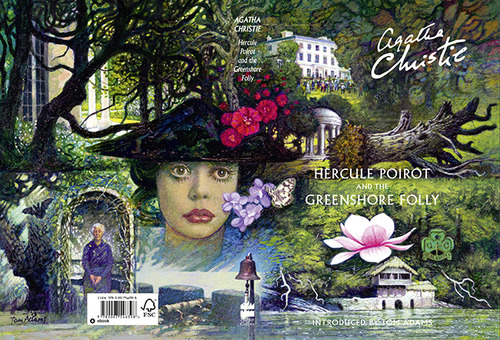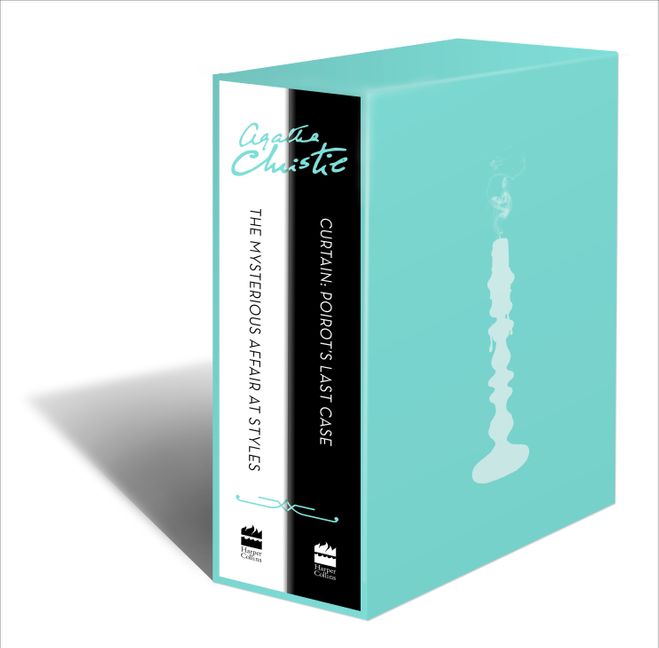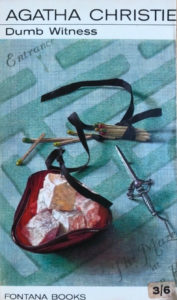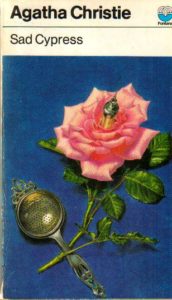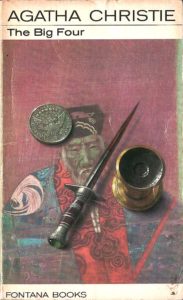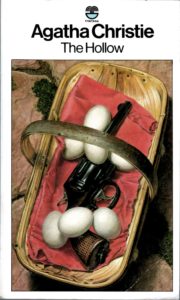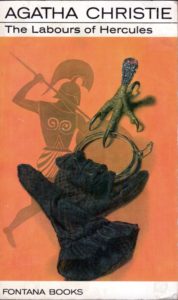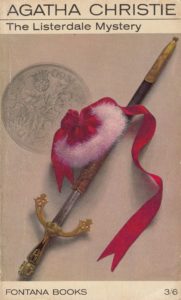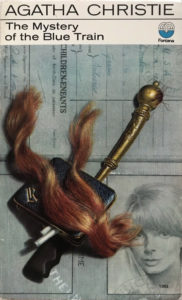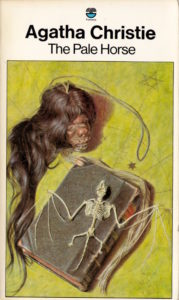Agatha Christie & the Cover Art of Tom Adams
Collecting » Authors & Artists » Agatha Christie » Tom Adams Covers
Agatha Christie, Tom Adams, & the Art of Murder
Please note that some of the links below are affiliate links for which I may be compensated (this does not affect my reviews nor cost you any money, but helps support my site hosting costs). I deeply appreciate your support of my site if you use these links, but warmly encourage you to buy from your local Indie bookshop if you have the opportunity.
Tom Adams
Tom Adams is one of the most familiar Agatha Christie artists in the world. He designed nearly all of the UK and European paperback covers for Fontana from 1963 (his first being A Murder is Announced) to 1979 (finishing with Miss Marple’s Final Cases), as well a couple of later special editions commissioned by HarperCollins to produce new covers for Hercule Poirot and the Greenshore Folly in 2014, and a matching set of The Mysterious Affair at Styles and Curtain (Poirot’s Last Case) in 2016. Tom was also contracted by Pocket Books to design 26 covers for the US market which were released between 1971 and 1974. These covers are quite different to the European designs, being mostly wraparound designs, which allow for more narrative movement across the image, and a more naturalistic style…..
For many of the Christie books Tom designed two, or even three different covers over the course of his work on her mysteries, and his mastery of different techniques and habit of hiding clever clues in the cover designs, combined with the familiarity of his work across different continents creates interest in collecting his paperback designs. Many of his UK designs also feature on the 1970s French ‘Librairie Des Champs Elysées’ editions, as well as the Spanish 1980s ‘Selecciones de Biblioteca Oro’ series published by Editorio Molino.
Other works
Tom’s cover art is also well known in works by other writers, including an iconic series of Raymond Chandler novels, as well as jacket art for John Fowles (The Collector, The Magus and The French Lieutenant’s Woman), Patrick White (The Vivisector) and Peter Straub (Ghost Story), not to mention creating special effects for Stanley Kubrick’s 2001 – A Space Odyssey and Mike Hodges’ Flash Gordon.

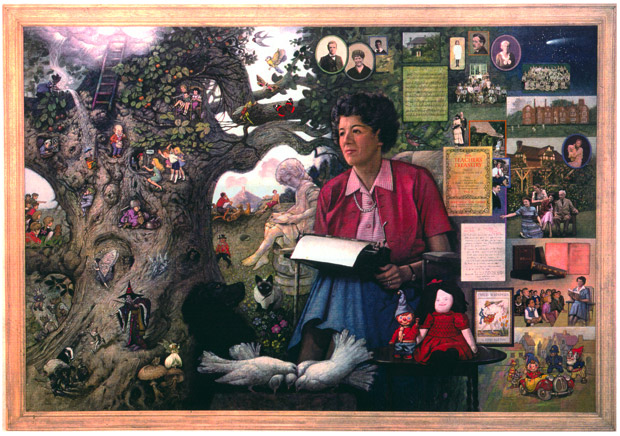
Tom's Christie covers
Tom has said he read each Christie novel he illustrated three times, first very quickly for the story and mood, second to make notes of characters or incidents, and third to choose ideas for the illustration. Early on he rejected the idea of showing Miss Marple or Poirot, rationalising that ‘the characters were so firmly fixed in the reader’s imagination that they could never be satisfactorily shown’.
In the collection of covers provided below, Tom Adams’ Pocket Book covers are listed first, followed by his covers for Fontana (several of which were later republished in the US and Canada under the Bantam imprint), and finally other publishers. There were also a number of covers released during the same time period when Tom was unavailable and another artist, Ian Robinson, was employed to create covers in the same style, and these are frequently mis-attributed as the artist is not listed on the cover – these are included separately as well for information.
There were a few Christie mysteries that were not initially illustrated by Tom because the rights for these books were not held by Fontana at the time he was employed to do the covers. These include the early books The Mysterious Affair at Styles*^, The Secret Adversary^, The Murder on the Links, The Man in the Brown Suit, Poirot Investigates^, and The Secret of Chimneys and the later publications Curtain (Poirot’s Last Case)*, Problem at Pollensa Bay and While the Light Lasts, nor the play texts (Mousetrap^) or Charles Osborne adaptations Black Coffee, The Unexpected Guest, and Spider’s Web.
* However, as noted above, Tom was later commissioned to produce covers for Hercule Poirot and the Greenshore Folly in 2014, as well as a matching set of The Mysterious Affair at Styles and Curtain (Poirot’s Last Case) in 2016.
^ Several of the novels were reprinted under the Bantam imprint in the early ’80s using Tom Adams’ cover art. Where cover did not exist, well, they simply took art from other covers without regard to how the illustrations related to the story – what a shocker!
How to find Tom Adams covers
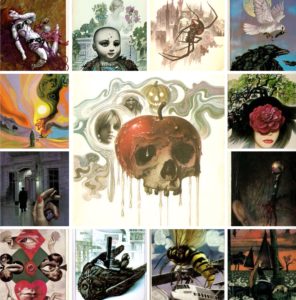
One of the cheapest ways to find Tom Adams covers is probably simply by haunting charity shops, second hand bookstores or eBay.
You can also find individual volumes online fairly easily via Abebooks, but it usually pays to check that the listing specifically identifies Tom as the cover artist, or else has a photo of the actual item in order to ensure you get the edition you want, rather than one of the many reprints by the same publisher with different covers. Because of this, I’ve included first printing dates where possible, and added general links to Abes below rather than links to specific books, as you really need to check each time and it’s frequently not possible to identify via ISBN.
Books about the Artist

Tom Adams Uncovered: The Art of Agatha Christie and Beyond
The story of one of the world’s greatest cover artists told through his iconic 1960s and 1970s Agatha Christie paperback designs, as well as a variety of other art and illustration from his 50 year career.
→ Buy Tom Adams Uncovered from Book Depository…
→ Buy Tom Adams Uncovered from Amazon.com…
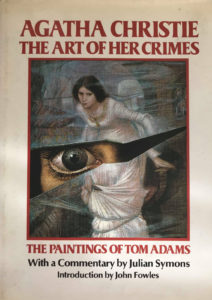
Agatha Christie: The Art of Her Crimes (also published as The Agatha Christie Cover Story)
A collection of over 90 book Christie cover paintings by Adams, including comments by Adams & Julian Symons.
→ Check availability of vintage The Art of Her Crimes (UK) at Abes…
→ Check availability of vintage The Agatha Christie Cover Story (US) at Abes…
Tom Adams' Wraparound Pocket Book Covers (US)
A Murder is Announced
Pocket Books #77611
The cover features an early scene from the book, where the lights go out at a dinner party and a door swings open, revealing a man with a blinding torch who demands the guests “Stick ’em up!” The woman in pink has erroneously been identified as Miss Marple, but in fact she does not join the story until later.

By The Pricking Of My Thumbs
Pocket Books #77582
The central grave in this scene is from a small churchyard in Hampstead, with the tombstones are based on a real cemetery near Wimbledon Common. The red-splashed rose in the foreground is a ‘Commandant Beaurepaire,’ the Perry’s York and Lancaster rose mentioned in the book.
Endless Night
Pocket Books #77583
This cover features the house at Gypsy’s Acre, and a sinister woman who warns of an ancient curse, along with several elements from William Blake’s poem “Auguries of Innocence” from which the book takes its title, especially ‘the bat that flits at close of eve’, and ‘the owl that calls upon the night’.
Ordeal By Innocence
Pocket Books 77554
The corridor in this cover was inspired by strange BBC version of Alice in Wonderland by Jonathan Miller.
The Mystery of the Blue Train
Pocket Books #77449
Interestingly, this is the only Christie cover in which Adams portrays one of the detectives – the dark figure on the back cover next to the blue train is intended to be Hercule Poirot. The front of course has a boardwalk in the French Riviera along with a handful of rubies.
Tom Adams' Agatha Christie Fontana Covers (UK/Europe)

The Murder of Roger Ackroyd
First published in 1926. Tom Adams cover published c1964.
The dagger in this image is a real Tunisian dagger, as described by Christie in the novel, which Tom stabbed through his own tweed coat to create the model for this image.
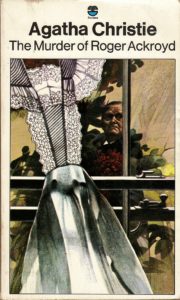
The Murder of Roger Ackroyd
First published in 1926. Tom Adams cover published c1974.
A later cover for The Murder of Roger Ackroyd, one that plays with perspective as we look through the study window.
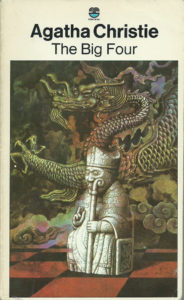
The Big Four
First published in 1927. Tom Adams cover published c1972.
The chess piece in this cover is one of the bishops from the famous Lewis Chess set, a group of distinctive 12th-century chessmen carved from walrus ivory. The Chinese dragon in the background symbolises some of the many Chinese elements in the tale.
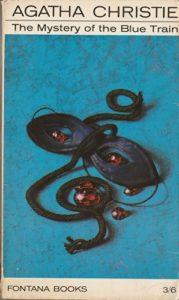
The Mystery of the Blue Train
First published in 1928. Tom Adams cover c1965.
The earlier cover for The Mystery of the Blue Train includes the story’s elements of disguise, strangulation, a jewel beyond price and the colour blue.
See also Ian Robinson covers.
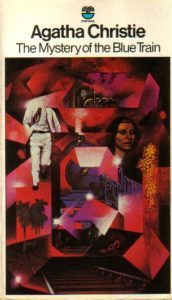
The Mystery of the Blue Train
First published in 1928. Tom Adams cover c1979.
This deep red cover provides different elements of the story, including the same blue train used for the US cover, broken up and reflected through the facets of a ruby.
See also Ian Robinson covers.

The Seven Dials Mystery
First published 1929. Tom Adams cover c1967.
Tom used his own glove and hand to model this image, and if you count them, of course there are seven clock dials in the background.
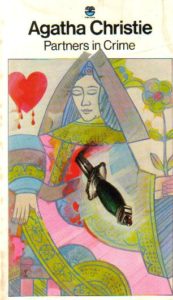
Partners in Crime
First published 1929. Tom Adams cover c1971.
This card-based cover is for a collection of short stories featuring the light-hearted sleuthing pair Tommy and Tuppence. It is drawn from the story Finessing the King / The Gentleman Dressed in Newspaper.
See also Ian Robinson covers.

The Mysterious Mr. Quin
First published 1930. Tom Adams cover c1965
The background is from a seventeenth century drawing showing Harlequin and Columbine. Tom’s intent with this cover was to convey the contrast between the hard cold brutality of the dark gun metal with the velvety softness of the Death’s Head Hawk moth. The revolver was borrowed from a friend and featured in several of his cover paintings.

The Murder at the Vicarage
First printed 1930. Tom Adams cover 1963.
The first early still life for The Murder At The Vicarage was painted in 1962, and includes an authentic 1930s tube of paint from the artist’s grandfather, and a Collin’s Crime Club novel in the bookshelf.
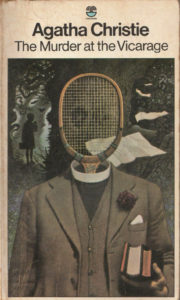
The Murder at the Vicarage
First printed 1930. Tom Adams cover c1968.
This later Murder at the Vicarage cover was painted only a few years later in 1968, but is a very different Magritte-type image. Tom borrowed an early racket from the Dunlop archives to ensure it had the right silhouette to reflect the time this first Miss Marple mystery was published in the 1930s.
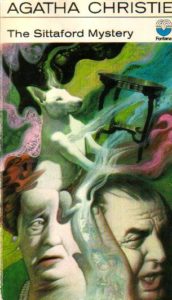
The Sittaford Mystery (US title: Murder at Hazelmoor)
First published 1930. Tom Adams cover c1971.
Both of the covers for this murder mystery set in a tiny Dartmoor village feature a swirling combination of many characters and elements from the story – giving you a lot of information, but not giving anything away.

The Sittaford Mystery (US title: Murder at Hazelmoor)
First published 1930. Tom Adams cover c1975.
Both of the covers for this murder mystery set in a tiny Dartmoor village feature a swirling combination of many characters and elements from the story – giving you a lot of information, but not giving anything away.
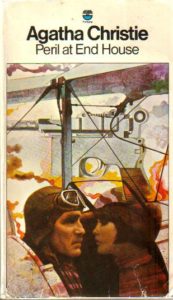
Peril at End House
First published 1932. Tom Adams cover c1973.
The pilot and his damaged plane on the UK cover of Peril at End House, along with one of the Buckley girls and the WW1 gun that shot one of them, are here intended to hint at the lament for the long lost hero-lover that prompt the action that leads to the mystery of this novel. The book was written in the wake of Amy Johnson’s solo flight to Australia in 1930.

The Thirteen Problems
First published 1932. Tom Adams cover c1971.
The cover for this story collection contains images primarily inspired by two of the stories, ‘Ingots of Gold’ and ‘The Blue Geranium’.
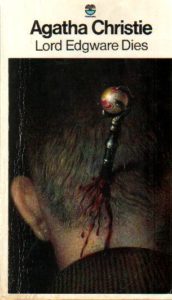
Lord Edgware Dies
First published 1933. Tom Adams cover c1965.
This UK cover for Lord Edgware Dies is an unusual Christie cover for Adams, as it includes a close-up image of the actual violent dagger attack, rather than his usual one-step-removed focus on the preparation or aftermath of murder.
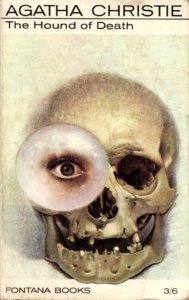
The Hound of Death
First published 1933. Tom Adams Fontana cover c1978.
This was Tom’s second Christie cover. He borrowed the skull from a friend, and added in the crystal ball and all-seeing eye as a nod to the other-worldly aspects of the tales in this collection.
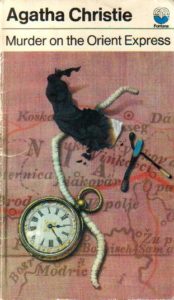
Murder on the Orient Express (US title: Murder on the Calais Coach)
First published 1934. Tom Adams Fontana cover c1972.
Resisting the desire to include a clichéd train on this cover, we instead see a map of Macedonia overlaid with other elements of the story, such as the pocket watch set at 1.15, burnt matches, charred paper and a pipe cleaner. The orange line shows the route of the Orient Express through the towns of Vinkovci and Brod.
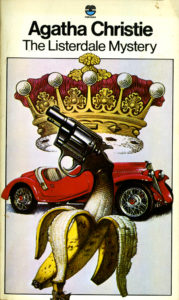
The Listerdale Mystery
First published 1934. Tom Adams cover c1975.
This short story collection was published only in the UK, although the stories therein appeared in other collections in the States. This montage cover includes elements from several stories, including a banana skin and revolver from The Golden Ball, car from The Manhood of Edward Robinson, and a representation of royalty from Swan Song.
See also Ian Robinson covers.

Why Didn’t They Ask Evans?
First published 1934. Tom Adams cover c1965
First Evans cover featured a montage with gun, golf ball and photograph.
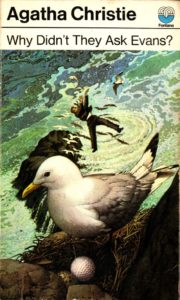
Why Didn’t They Ask Evans?
First published 1934. Tom Adams cover c1972.
Second Evans cover featured a golf ball, seagull and body in the water.
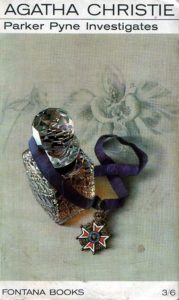
Parker Pyne Investigates (US title: Parker Pyne, Detective)
First published 1934. Tom Adams cover c1965.
Another beautiful trompe l’oeil painting with a beautiful two-dimensional botanical drawing the background offset with the gorgeous three-dimensional cut glass decanter and medal of the ‘Order of St Stanislaus’, tenth class with laurels, which ends up draped around the neck of the City Clerk.
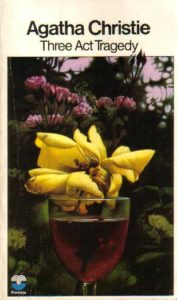
Three Act Tragedy
First published 1935. Tom Adams Fontana cover c1972.
The cover of Three Act Tragedy features Bartholomew Strange’s port glass, and a rose which is related to the method of extraction of the poison in the story (although the artist has noted that the port glass should have been cut glass in accordance with the story).
Death in the Clouds
First printed 1935. Tom Adams cover c1969.
The UK cover of Death in the Clouds makes use of an interesting perspective, with the wasp in the foreground and a period plane in the background. In this cover, the plane is named Henquist, however this was corrected to Prometheus as per the story when it was later reproduced on a Collins cover.
The A.B.C. Murders
First published 1936. Tom Adams cover c1973.
This cover features an actual ABC or alphabetical railway guide, a monthly railway timetable guide to the UK, originally published during the expansion of the British railway network. Victim B is shown within the frame, on the beach at Bexhill. Christie’s grandson, Mathew Prichard, claimed in an interview that the story was inspired by a copy of the ABC guide that Agatha always kept by her telephone.
Murder in Mesopotamia
First printed 1936. Tom Adams cover 1964.
For this cover of one of Christie’s most archaeological murder mysteries, Tom has painted here a plasticine death mask he created, along with other elements from the story, including a threatening letter, fake goblet, and that very hairy rope.
Cards on the Table
First published 1936. Tom Adams cover c1978
The cover for Cards on the Table is an interesting representation of the bridge game that forms the setting for the murders in this book. The image includes elements Tom has extracted from a John Collier painting called The Cheat, which shows four people playing bridge at the moment they discover one of them is cheating.
Uncommon. See also Ian Robinson covers.
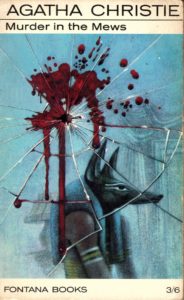
Murder in the Mews (US title: Dead Man’s Mirror)
First published 1937. Tom Adams cover c1964.
The cover for this collection of short stories includes elements from two of the stories – a mirror, one of Christie’s favourite devices, which is reflecting Anubis, the Egyptian God of Death.
Hercule Poirot’s Christmas (US: Murder for Christmas, A Holiday for Murder)
First published 1938. Tom Adams Fontana c1963.
Christie’s dedication for this book notes that she wrote it in response to her brother-in-law’s request for “a good violent murder with lots of blood”, and the various covers Tom painted for this one reflect that sentiment, with blood dripping from holly leaves simultaneously conveying both murder and Christmas.
Uncommon.
Hercule Poirot’s Christmas
First published 1938. Tom Adams cover c1972.
Christie’s dedication for this book notes that she wrote it in response to her brother-in-law’s request for “a good violent murder with lots of blood”, and the various covers Tom painted for this one reflect that sentiment, with blood dripping from holly leaves simultaneously conveying both murder and Christmas.
Hercule Poirot’s Christmas
First published 1938. Tom Adams cover c1978.
Christie’s dedication for this book notes that she wrote it in response to her brother-in-law’s request for “a good violent murder with lots of blood”, and the various covers Tom painted for this one reflect that sentiment, with blood dripping from holly leaves simultaneously conveying both murder and Christmas.
Uncommon. The same image was republished as ‘A Holiday for Murder’ under the Bantam imprint.
Murder is Easy (US title: Easy to Kill)
First published 1939. Tom Adams cover c1980.
The UK cover features similar elements to the US version which is titled Easy to Kill, with the deliciously creepy forest background and the rooster and dagger in the foreground, but this one includes additional tormented faces, which I think makes it more gruesome.
And Then There Were None (also published as Ten Little Niggers and Ten Little Indians)
First published in 1939. Tom Adams cover published c1971.
This novel was renamed several times as the earlier titles made use of ethnic slurs, using lines from a then-popular nursery rhyme. Tom’s cover makes use of a golliwog doll, a toy also considered controversial today.
Sad Cypress
First published 1940. Tom Adams cover c?
The photo used for this cover is based on one of his father, taken during the First World War, a scratch from a rose is one of the clues in the case, and the will is suggestive of the location of the story, which unusually for Christie is a courtroom drama. Overall, the gentle nature of this image reflects the love story elements of the novel.
Uncommon. See also Ian Robinson covers.
One, Two, Buckle My Shoe (US title: Patriotic Murders)
First published 1940. Tom Adams Fontana cover c1967.
This is one of Tom’s early covers, and the first to use a nursery rhyme illustration in the background, with an innocent image, brutally torn through with that menacing gun barrel pointing directly at the reader’s face.
The Body in the Library
First published 1942. Tom Adams cover c1967.
Tom’s cover for The Body in the Library is unusual in that it doesn’t feature the library at all, focusing instead on the foot of the corpse, with white beads to represent the white spangled satin of the dress, and a couple of flies to symbolise death and decay.
The Moving Finger
First published 1943. Tom Adams cover c1969.
Another seemingly innocent cover for The Moving Finger in fact features dark elements of the novel, which features poison pen letters made of words cut from old documents, a victim found with a glass of potassium cyanide, and a pestle used to attack. The torn document in the background is from a volume of Record Office facsimiles in Tom’s collection – and Miss Marple uses a torn piece of paper to determine the culprit.
Death Comes as the End
First published 1945. Tom Adams cover c1968.
The mural in the background reflects Christie’s inspiration for this novel, which came from a couple of letters from the eleventh dynasty of ancient Egypt. The body represents the embalmed Nofret, and the toy lion that Hori repaired for Renisenb is placed inside the disheveled mummy wrappings.
The Hollow
First published 1946. Tom Adams cover c1963.
I love the simplicity of Tom’s cover design for The Hollow, with the distortion of the water creating a barrier between the viewer and the revolver beneath it.
See also Ian Robinson covers.
The Labours of Hercules
First published 1947. Tom Adams cover c1976.
The cover for The Labours of Hercules plays with Christie’s description of several characters as having “long curved noses, like birds… over their shoulders they wore loose cloaks that flapped in the wind like the wings of two big birds”, with another decaying apple adding to the creepy atmosphere of the scene.
A Murder is Announced
First published 1950. Tom Adams cover c1963.
A Murder is Announced was Tom’s first Christie cover, painted for Fontana in 1962. It introduces his still life style, with simple items made menacing, such as the wilting violets and blood splatter on the news cutting, as well as his trompe l’oeil style with the bullet holes in the wallpaper providing a three dimensional sense to the image.
A Murder is Announced
First published 1950. Tom Adams cover c1974.
This later cover makes use of the violets and timepiece again, but introduces a menacing figure in the doorway.
See also Ian Robinson covers.
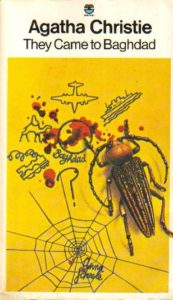
They Came to Baghdad
First published 1951. Tom Adams cover c1968.
This cover is based on a sketch in one of Agatha’s notebooks, with the added insect and blood drops, as well as the spider’s web entangling the name of one of the main characters.
Mrs. McGinty’s Dead
First published 1952. Tom Adams cover c1974.
This later cover for Mrs McGinty’s Dead is very similar to the US Pocket book cover, with another similar cameo setting of the charwoman’s parlour, including the remains of McGinty’s supper of kipper, bread and margarine as described in the book.
They Do It With Mirrors (US title: Murder With Mirrors)
First published 1952. Tom Adams cover c1967.
The iconic cover of They Do It With Mirrors features a lovely mirror trick itself, with a gun sitting on sheet music for Chopin’s Prélude in E♭ major, reflected in several mirrors that cleverly cut the garden background in half.
A Pocket Full of Rye
First published 1953. Tom Adams cover c1973.
This cover focuses on the nursery rhyme ‘Sing a Song of Sixpence’ which contains the line ‘A Pocket Full of Rye’ from which the book title is taken – you can see the music from the rhyme in the background showing the line ‘down came a blackbird and picked off her nose’ (reflecting the maid who was found strangled with a clothes peg on her nose), along with the rotting skeleton of a blackbird. The yew berries are used to create taxine, the poison used to kill ‘the king’.
Destination Unknown
First published 1954. Tom Adams cover c1969.
These gorgeous surrealistic covers for Destination Unknown owe much to Dali according to the artist. The first version is quite different to the still life covers that came before it, including as it does such bright psychedelic images, along with the faked plane crash, leper and a broken necklace from the story.
Destination Unknown
First published 1954. Tom Adams cover c1975.
This later cover has some fabulous dark rocks transforming into sinister toads, along with the dark hooded leper in the foreground. The metamorphosis of the rock is a reference to the character of Mr Aristides, who is described as a ‘small yellow toad’.
Hickory Dickory Dock (US title: Hickory Dickory Death)
First published 1955. Tom Adams Fontana cover 1972.
This later cover keeps the same colouring, but the story elements included in this cover are a disturbingly green frightened girl, a diamond ring that ties various elements of the story together, and an adorable mouse which ‘ran up the clock’ in the nursery rhyme from which the title is drawn.
Dead Man’s Folly
First published 1956. Tom Adams cover c1973.
A beautifully romantic pre-Raphaelite sunset in the background of this beautiful field of flowers is shockingly marred by the body of the girl guide that is found in the boathouse in the story. The girl is similar to the body in the American cover, but the rest of the scene is strikingly different.
4:50 From Paddington (US title: What Mrs McGillicuddy Saw)
First published 1957. Tom Adams cover c1967.
The Fontana 4:50 from Paddington cover contains various clues from the story, including a compact, a piece of fur and a flower sprig that were dropped from the body as it was dragged to the sarcophagus. (Tom – always a perfectionist – later noted his frustration that he painted a hawthorn blossom, not remembering at the time the story was set in winter.) The background image is based on a real Roman sarcophagus.
Ordeal By Innocence
First published 1958. Tom Adams Fontana cover c1963.
This is one of the titles for which Tom painted multiple covers – 4 including the American version. This earliest makes use of a broken cup and dagger still-life, which references the two clues that unravel the second murder – the coffee cup and the feathers of the dove from the poem.
The Pale Horse
First published 1960. Tom Adams cover c1964.
A darkly chilling cover, the illustration bringing to mind black magic and the sinister goings on in Much Deeping.
See also Ian Robinson covers.
The Mirror Crack’d from Side to Side
First published 1962. Tom Adams cover c1965.
The line “The mirror crack’d from side to side” comes from one of my favourite Tennyson poems, The Lady of Shalott, and this Fontana cover is one of my favourites. It actually features a delicate figure based on from a painting of the Lady of Shalott by the Victorian painter John William Waterhouse, juxtaposed against that wide bloodshot eye looking through the crack. A stunning interpretation.
Third Girl (Also published as The Third Girl)
First published 1966. Tom Adams Fontana cover 1979.
One of the victims in this novel, David, is referred to as a ‘peacock’, hence the feathery background, and the dagger cuts through the number 67, the flat where the protagonist Norma lives, the titular ‘third girl’ of the novel.
Endless Night
First published 1967. Tom Adams Fontana cover published c1970.
To create this stunning cover, Tom rang up the RSPCA in London on the off-chance they might have a dead bird available, and as luck would have it, they had just been given this Tawny owl that had ‘died in mysterious circumstances’.
By the Pricking of My Thumbs
First published 1968. Tom Adams cover c1971.
The macabre doll’s head found in the chimmney is described as having lost one of its eyes, and the sinister cracks in its china head add to the general feeling of menace. The original illustration that you can see here had more elements, but there was a stipulation by the publishers that there be only one central element on the cover for the first time they appeared in paperback, so a simpler version was used instead. Later editions often flipped the image to face the other direction.
Hallowe’en Party
First published 1969. Tom Adams Fontana cover published 1971.
Bobbing for apples is part of the fun at the Hallowe’en party in this story, and this fabulous collision between a juicy apple turning into a dripping skull (the same one used in the Hound of Death), surrounded by swirling water revealing a menacing pumpkin, an evil witch, and a beautiful girl.
Passenger to Frankfurt
First published 1970. Tom Adams Fontana cover 1972.
In the early cover for this book, the female villain is represented by the black widow spider at the centre of her web. Similar to the US edition it also features the statue of Siegfried and Neuschwanstein castle in the background.
Elephants Can Remember
First published 1972. Tom Adams Fontana cover 1978.
This is another cover featuring many different elements from the plot, put together to create a charming composition through which the ghostly ‘remembering’ elephant is wandering. Tom has noted his inspiration for the dog from Landseer’s terrier, and the background landscape from The Scapegoat by William Holman Hunt.
Postern of Fate
First published 1973. Tom Adams Fontana cover 1974.
The dramatic rocking horse in the foreground of this cover is Mathilde, described in the book as “a rather splendid-looking horse even in decay”. The decaying greenhouse in the background was based on the greenhouse from his own garden.
Poirot’s Early Cases
First published 1974. Tom Adams cover c1979.
The rather gruesome cover of Poirot’s Early Cases is a compendium image that includes elements from several of the short stories in the collection, including a bee-sting, the head of a ventriloquist’s dummy, and a collection of jewels used on the bee’s legs instead of pollen. (Unfortunately, much was lost from the original artwork when this piece was adapted for the truncated ‘new in paperback format’.)
Sleeping Murder
First published 1974. Tom Adams cover c1976.
Sleeping Murder was the last published Miss Marple, written many years before publication but intended to appear after the author’s death. The needle and ball of wool framing the dead young girl are clearly symbolic of Miss Marple, and part of a loving memorial in this special paperback release.
Miss Marple’s Final Cases
First published 1979. Tom Adams cover c1980.
The disparate collection of different elements on the cover for Miss Marple’s Final Cases reflects the collection of different mysteries in this short story collection, and this was in fact the last cover Tom painted for Fontana. It’s available only in the smaller size for the ‘new in paperback’ edition, as later editions used different cover art.
Tom Adams Christie Covers with other publishers
The Agatha Christie’s Who’s Who by Randall Toye
First published 1980 Holt Rinehart & Winston with Tom Adams portrait on cover
A fictional almanac of characters in Christie’s novels.
The Life and Crimes of Agatha Christie by Charles Osborne.
First published 1982 by Collins with Tom Adams wraparound cover
Osborne’s biography of Christie’s life.
Hercule Poirot and The Greenshaw Folly by Agatha Christie
First published 2014 by Harper Collins with Tom Adams wraparound cover
In 1954, Agatha Christie wrote this novella with the intention of donating the proceeds to a fund set up to buy stained glass windows for her local church at Churston Ferrers, and she filled the story with references to local places, including her own home of Greenway. But having completed it, she decided instead to expand the story into a full-length novel, Dead Man’s Folly, which was published two years later, and donated a Miss Marple short story (‘Greenshaw’s Folly’, included in The Adventure of the Christmas Pudding) to the church fund instead.
The book includes a jacket painting, illustrations and exclusive introduction by Tom Adams.
2016 (Harper Collins)
Styles: The Mysterious Affair at Styles and Curtain: Poirot’s Last Case [Centenary Boxed Set]
A special 100th anniversary edition that brings together the first Poirot novel with her last.
In addition to newly commissioned cover paintings by Tom Adams, it also includes special introductions; a unique pull-out letter by Christie in which Hercule Poirot introduces himself to his editor; an article by Christie (‘Drugs and Detective Stories’), written for University College Hospital Magazine in 1941, about the inspiration for her first book; and Christie’s original unpublished courtroom ending to The Mysterious Affair at Styles, introduced by Christie expert Dr John Curran.
'Mimic' Fontana Covers by Ian Robinson
Five Little Pigs
Ian Robinson cover c1968.
This cover refers to the scene of the crime – the battery at Avonbury – and includes the pipette used to introduce the fatal poison.
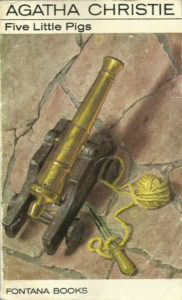
Video Review
I created a video review on “The Art of Murder” for an earlier blog post. The video looks at the fabulous vintage paperback covers for Agatha Christie titles from the 1960s, 1970s, and 1980s – most of which is also covered in the text above.
Further reading
There are lots of excellent sites about Agatha Christie and Tom Adams on the internet. These three are my favourites:
Tom Adams and Agatha Christie: A Facebook Group devoted to the Tom Adams covers, to whom I am indebted for their original research into which Fontana covers are Tom’s or Ian’s.
The Home of Agatha Christie: The Official Agatha Christie Website
Tom Adams Uncovered: The artist’s own website, where you can buy prints of some of his artwork [this page is currently offline]

